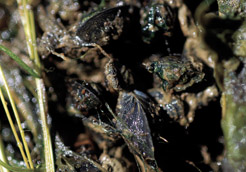
The state and federal environmental review of a plan to rid San Justo Reservoir of invasive zebra mussels continues this summer as the once-popular recreation area remains closed to the public for a fourth year.
“Those documents need to be completed and uncontested,” said Jeff Cattaneo, who heads the San Benito County Water District. “Most people want to see something go forward. I think we’ve done a pretty good job to mitigate any impacts there might be” from the treatment plans being proposed.
The $2 million to $3 million proposed project would draw down the reservoir level and treat the mussels with potash – or potassium chloride – a type of salt that disrupts mussels’ ability to filter feed. Officials believe the application of potash would force the mussels to open, at which time they could be killed with chlorine or left to die on their own.
The documents being prepared now address any potential impacts that the treatment plan would have. The next step would be to move to the final design of the project and seek funding for it.
“The reservoir is going to remain closed until either we have a complete eradication or there’s a suitable program in place to ensure the mussels don’t go anywhere from San Justo,” which supplies agricultural water to local farmers.
The concern is that boaters or fishermen could inadvertently transfer the mussels from San Justo to another waterway, spreading the infestation. Zebra mussels, which are not native to California, reproduce so quickly and in such great numbers that they can clog drinking water systems or agricultural irrigation pipes.
“Issues include what kind of access there would be to San Justo and who’s going to be monitoring it,” Cattaneo said. “That’s a big concern for everybody locally and regionally.”
The mussel population in San Justo remains “fairly static,” Cattaneo said.
“We’ve been doing periodic draw-downs (of the reservoir level) to control the population each year, and that appears to have had some success,” he said.
Mussels have been found in the Hollister Conduit, which distributes water from the reservoir to farmers, but the infestation is “limited” and “not as much as one would expect,” according to Cattaneo.
“If it were that the mussels only infested the reservoir and they didn’t get into the infrastructure of the Hollister Conduit and the distribution system, for us that would not be a huge issue,” he said. “The biggest problem for water agencies is that the mussels get into their distribution systems, proliferate and clog everything up. If they were only contained in San Justo and never got into the distribution system, the mussels are really not hurting the reservoir that much – they really don’t affect the fish population and because they are filter feeders, in some respects they keep the water cleaner.”
The entrance to San Justo on Union Road remains locked, though some people have ignored the closure signs in an attempt to fish the reservoir.
“Occasionally somebody will try to sneak in and go fishing,” Cattaneo said. “Sheriff’s deputies go in there periodically as a courtesy to us to run people off with the threat of being arrested for trespassing.”









